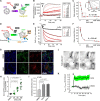Molecular and cellular dissection of the oxysterol-binding protein cycle through a fluorescent inhibitor
- PMID: 32075908
- PMCID: PMC7105299
- DOI: 10.1074/jbc.RA119.012012
Molecular and cellular dissection of the oxysterol-binding protein cycle through a fluorescent inhibitor
Abstract
ORPphilins are bioactive natural products that strongly and selectively inhibit the growth of some cancer cell lines and are proposed to target intracellular lipid-transfer proteins of the oxysterol-binding protein (OSBP) family. These conserved proteins exchange key lipids, such as cholesterol and phosphatidylinositol 4-phosphate (PI(4)P), between organelle membranes. Among ORPphilins, molecules of the schweinfurthin family interfere with intracellular lipid distribution and metabolism, but their functioning at the molecular level is poorly understood. We report here that cell line sensitivity to schweinfurthin G (SWG) is inversely proportional to cellular OSBP levels. By taking advantage of the intrinsic fluorescence of SWG, we followed its fate in cell cultures and show that its incorporation at the trans-Golgi network depends on cellular abundance of OSBP. Using in vitro membrane reconstitution systems and cellular imaging approaches, we also report that SWG inhibits specifically the lipid transfer activity of OSBP. As a consequence, post-Golgi trafficking, membrane cholesterol levels, and PI(4)P turnover were affected. Finally, using intermolecular FRET analysis, we demonstrate that SWG directly binds to the lipid-binding cavity of OSBP. Collectively these results describe SWG as a specific and intrinsically fluorescent pharmacological tool for dissecting OSBP properties at the cellular and molecular levels. Our findings indicate that SWG binds OSBP with nanomolar affinity, that this binding is sensitive to the membrane environment, and that SWG inhibits the OSBP-catalyzed lipid exchange cycle.
Keywords: Golgi; ORPphilin; OSBP; cholesterol; lipid transport; lipid-transfer protein; phosphoinositide; protein drug interaction; schweinfurthin.
© 2020 Péresse et al.
Conflict of interest statement
The authors declare that they have no conflicts of interest with the contents of this article
Figures




References
-
- Burgett A. W., Poulsen T. B., Wangkanont K., Anderson D. R., Kikuchi C., Shimada K., Okubo S., Fortner K. C., Mimaki Y., Kuroda M., Murphy J. P., Schwalb D. J., Petrella E. C., Cornella-Taracido I., Schirle M., Tallarico J. A., and Shair M. D. (2011) Natural products reveal cancer cell dependence on oxysterol-binding proteins. Nat. Chem. Biol. 7, 639–647 10.1038/nchembio.625 - DOI - PMC - PubMed
Publication types
MeSH terms
Substances
LinkOut - more resources
Full Text Sources
Other Literature Sources
Molecular Biology Databases
Research Materials
Miscellaneous

